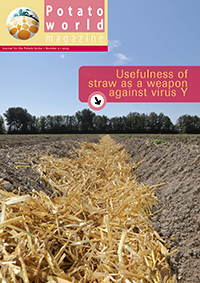Already a subscriber? Activate your premium account

Potatoworld Magazine

“There is no magical single trait to evaluate drought tolerance as it is as complicated and difficult to plant biology as cancer is to mammalian biology”. This is one of the propositions belonging to the thesis of dr. Anithakumari A.M. who did her PhD recently at Wageningen University.
With some other traits such as potato cyst nematode resistance and virus Y resistance such golden bullets do exists and complete resistance – immunity – can be achieved. This also holds for late blight but here immunity can be overcome by the pathogen through adaptation. Here the relationship is based on a single gene in the pathogen and a single gene in the potato, a qualitative trait. A gene-for-gene relationship. With drought the matter is far more complicated as drought resistance – tolerance rather – is not based on a single gene but on many genes: a so call quantitative trait. A plant can be more or less tolerant of drought than another plant. To find out if a plant suffers from drought, from withholding water from a pot in the greenhouse, a number of phenomena can be measured. The most important ones are the following. The relative water content of its leaf by comparing the weight of a leaf of a plant submitted to drought after removing it from the stem, with the same leave after some time after it was placed in moist conditions and allowed to soak up water. The water use efficiency, i. e. the amount of water needed to produce one gram of potato plant. This is correlated with the percentage of carbon 13 in the plant that is less favoured than the more abundantly present carbon 12. But when the plant is dry the stomata close and is carbon 13 discriminated against to a lesser extent; this may have two components, one related to the stomata and one related to chlorophyll. The amount of chlorophyll is measured and chlorophyll fluorescence meaning light that is firsts absorbed by the leave but then rejected which happens more when a plant is growing in drier conditions. Haulm, root and tuber weight were also recorded as well as length of the plants. The researchers – also PhD students work in teams and Anitha was supervised by dr. Gerard van der Linden – also tried shoots in vitro where drought was mimicked by a high concentration of some kind of glycol.

The plants were coming from crosses of plants from a collection at the University that is well described and numerous genes and their exact location on the genome (chromosomes) known. For quantitative traits such as drought tolerance quantitative trait loci (QTLs, stretches of DNA linked to drought) need to be mapped on the genome. This is done with molecular tags of which many hundreds were added recently with the potato genome sequencing project delivering the complete potato genome. The research yielded 23 new such loci related to the various drought tolerant reactions mentioned above and also to the reactions when drought was relieved. Many QTLs were specific for either in vitro or in greenhouse conditions but some ( plant length, dry and fresh weight of the shoot) were generic for both conditions and their apparent independence of growing conditions likely make them suitable for screening for drought tolerance in the field. It is significant that some in vitro (meaning low cost rapid throughput) detected traits possibly can be used to predict performance of some traits under field conditions.
For potato genetics and breeding these insights and actual findings and fine tuning of QTLs and hints at single genes that are responsible for a single event such as fluorescence or the stomatal component of carbon 13 uptake are useful as they will allow breeders to look for the presence of certain QTLs in the population used as parents for crosses and also for relevant observations when subjecting their material to drought and relieving it from drought after some time. ●
Events
©2015 - 2024 Potatoworld | Webdesign and realisation COMMPRO